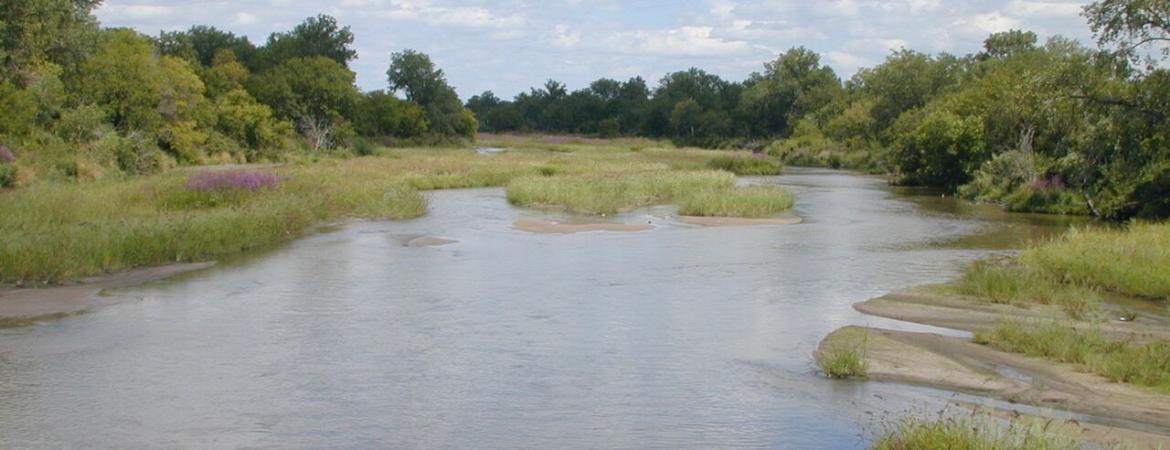Water
Water
Farmers, ranchers, urban residents, industries, recreationists, livestock and wildlife all depend on Nebraska's most precious natural resource – water. Water is vital to life. Thanks largely to the High Plains Aquifer, Nebraska has more groundwater than any other state. Two thirds of the High Plains Aquifer’s total water storage is in Nebraska. The Ogallala Aquifer is part of the High Plains Aquifer that spans eight states and covers 175,000 square miles. If poured over the surface of the state, the water in those aquifers would have a depth of 37.9 feet (11.6 meters).
Above ground, the state is laced with nearly 80,000 miles of flowing rivers and streams. Nebraska's major river basins include the Missouri, Platte, Niobrara, Loup, Republican, Elkhorn, Nemaha and Blue.
Though it is plentiful and usable, Nebraska's water is neither infinite nor immune from pollution. Irrigators, cities and villages, industries and wildlife all compete for this precious resource. Contamination may come from sediment, farming chemicals, urban runoff and industrial sources.
Natural Resources Districts (NRDs) have local leadership responsibilities for protecting groundwater from overuse and pollution. Each district also has a plan to protect groundwater. State law has given districts a variety of regulatory tools to deal with contamination, shortages or user conflicts.
NRDs encourage stewardship by providing financial assistance to landowners for irrigation water management and best management practices to protect water. NRDs are not just water protectors, in some cases they are providers. A number of NRDs operate drinking water systems for rural customers and small communities.
Nebraska Water Facts (2024)
NRD Groundwater Management
- NRD Groundwater Quantity and Quality Regulations (updated Jan. 2025)
- NRD Groundwater Management Summary (updated Jan. 2025)
- Nebraska Groundwater Irrigated Acres Summary (updated 2024)
Watershed and Flood Prevention Operations (WFPO) & Dam Rehabilitation
- WFPO Fact Sheet (March 2025)
- Dam Rehab Fact Sheet (March 2025)
Perkins County Canal Project
- Perkins County Canal Fact Sheet (Jan. 2025)
- Perkins County Canal Fact Sheet (Nov. 2022)
- Perkins County Canal Fact Sheet (Dec. 2022)
- NDNR Fact Sheet
- Video: South Platte River Compact Fundamentals and Connections
- Video: Visual Tour of South Platte Return Flow Conditions
- Video: How Colorado is Currently using Return Flows
- Video: Perkins County Canal Project Operations and Overview
NRD Water Projects
- NCORPE - (Nebraska Cooperative Republican Platte Enhancement Project)
- NCORPE Public Access Program - Hunting Rules and Regulations, More Public Uses Expected In Future!
Groundwater Quality
Nebraska’s NRDs lead the nation in groundwater quality management by targeting areas with known non-point source contamination. Soil type and depth to water are the main factors in determining the vulnerability of groundwater. Best Managements Practices (BMPs) such as irrigation management and proper nitrogen/pesticide applications, are needed to prevent contaminant from entering Nebraska’s drinking water.
- Nebraska Department of Environment & Energy Nebraska Nitrate in Drinking Water Study (January 2025)
- Testing your private well for nitrates (Video)
- How do Nitrates get into your Groundwater?
- Six Easy Ways to Prevent Nitrates from Entering Nebraska's Groundwater
- Nebraska Nitrate Working Groups
- UNL Nitrogen Tool - Calculate the amount of nitrogen fertilizer needed for farm fields (released December 2023)
Water Education
The Nebraska Watershed Aquifer Virtual Education System (WAVES) is devoted to Nebraskans who are:
- Engaged in water management processes
- Interested in how water moves through our watersheds and aquifers
- Looking for the latest water research stories
Producer Connect (app to reduce nitrogen application)
In June 2023, the Nebraska Association of Resources Districts and 17 of Nebraska's 23 Natural Resources Districts (NRDs) along with the Nebraska Corn Board, Central Valley Ag, Corteva and the Nebraska Cooperative Council announced the development of a nitrogen dashboard in partnership with Longitude 103, a leading provider of agricultural technology solutions. Producer Connect, a web and mobile application suite, allows producers to access their crop reporting data and includes a fertilizer recommendation based on yield goals. This collaborative effort aims to empower agriculture producers to optimize inputs, which will enhance agricultural profitability, water quality and irrigation efficiency. The app is now being launched in NRDs across the state. Read more about the app:
- Nebraska Examiner, "New app deployed to help cut overapplication of nitrogen fertilizer"
-
Innovative Nitrogen Dashboard to Improve Fertilizer Efficiency, Water Quality
-
Central Valley Ag Partners to Improve Fertilizer Efficiency, Water Quality
-
NRDs and Corteva Agriscience Collaborate on Producer Connect
-
Nebraska Cooperative Council Partners with NRDs on Producer Connect
Nitrogen Reduction Incentive Act
On April 11, 2024, Nebraska Senators approved the creation of a program to incentivize the reduction of nitrogen use in Nebraska farming practices. LB1368 sponsored by Sen. Theresa Ibach, created a nitrogen reduction incentive program to be administered by the Nebraska Department of Natural Resources. The program is funded through a one-time transfer of $1 million from the Water Resources Cash Fund to a newly created Nitrogen Reduction Incentive Cash Fund, and $100,000 in general funds in FY2024-25 and FY2025-26. Applications open Oct. 22, 2024, and the deadline to apply through the local NRD is Jan. 15, 2025.
Nebraska MEDS
Did you know you should never flush leftover medication? If kept in the medicine cabinet, unused or expired medications can fall into the wrong hands and lead to accidental poisoning or illegal use. But you shouldn’t just toss or flush them. Properly dispose of them by returning them to a participating pharmacy. Find a pharmacy near you here! Or call 1-800-222-1222.

